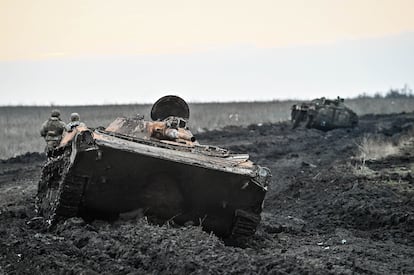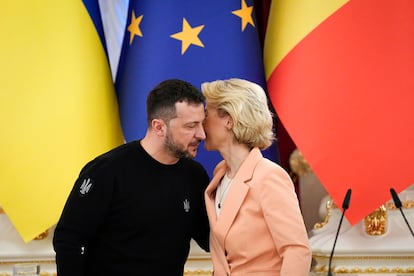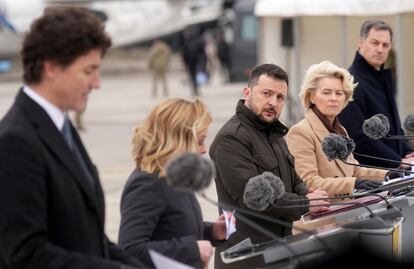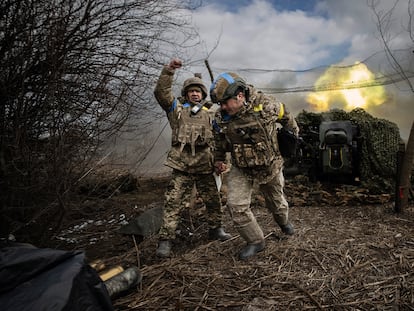Ukraine, year three: The moment of survival
Western leaders are showing their support for Zelenskiy in Kyiv, but without major economic or military aid announcements. Ursula von der Leyen, the president of the European Commission, continues to praise the Ukrainian military: ‘You saved your country, you saved all of Europe’

The first months of Russia’s full-scale invasion of Ukraine saw resistance prevail. Then came the time for the liberation of the territories captured by Russian President Vladimir Putin, with financial support and weapons sent by the Western allies. This was followed by a long-awaited counteroffensive, which ultimately did not come to fruition.
Now, Ukraine is beginning the third year of a large-scale war of survival. The country faces new tests on the frontlines, with exhausted troops and a lack of ammunition. Russia, meanwhile, has recovered the initiative. According to some sources, the Kremlin is preparing a new major offensive by the end of spring.
At home, away from the fighting, Kyiv also has significant obstacles to overcome. President Volodymyr Zelenskiy’s administration must maintain the support of an exhausted citizenry. And, even farther away, the support of Ukraine’s principal ally — the United States — is floundering. The European Union fears being left alone to support Kyiv as it fights an endless war on the continent. It’s a critical moment in the fighting: if Ukraine overcomes it, it will be able to regain the advantage.
“We must do everything to make 2024 a decisive year for restoring real long-term security in Ukraine and around the world,” Zelenskiy stressed this past Saturday, while meeting with Italian Prime Minister Giorgia Meloni (rotating president of the G-7), Canadian Prime Minister Justin Trudeau, Belgian Prime Minister Alexander de Croo (current president of the Council of Europe) and president of the European Commission Urusula von de Leyen, of Germany.
At Hostomel Airport — one of the symbols of the Ukrainian resistance that prevented Russian troops from taking the capital after the full-scale invasion began in 2022 — Western leaders have tried to show that, although Washington’s support is at risk, the rest of the allies won’t falter. The visit by the heads of state, however, hasn’t been accompanied by major economic or military announcements (although Canada has promised an extra $2 billion for Kyiv).
“You saved your country. You saved all of Europe,” Von der Leyen declared, before dozens of soldiers who participated in the battle for Hostomel, an airfield that will be rebuilt by the Ukrainian aeronautical company Antonov, at a cost of $1 billion in funding from various EU nations. “We will continue to support Ukraine in what I have always deemed the just right of its people to defend itself,” Meloni affirmed.
Von der Leyen has also assured Zelensky that, by mid-March, she will present the negotiating framework for Kyiv’s accession to the EU. However, just a few days earlier — on Wednesday, February 21 — she had announced that this roadmap would only be presented at the end of summer. This stung not only the Ukrainian authorities, but also the European Council and many European capitals, making her look bad. Many have attributed her flip-flopping to her attempt to win a second term as president of the Commision. “The best security guarantee will be the membership in the European Union,” Von der Leyen claimed on Saturday.
The enlargement of the EU towards the east — which will change the bloc forever — and the absorption of Ukraine is a point of tension in some EU member states. Countries such as Poland — with a large agricultural base, like Ukraine — see the embattled country as a competitor. Hence, this is another test that Kyiv must go through in 2024. It must deepen its internal democratic reforms to assimilate into the EU and advance along the path of accession.

The majority of Europeans support Ukraine’s entry into the EU. However, polls also reveal that pessimism has increased in many EU countries regarding Ukraine’s chances of winning the war: only 10% of Europeans believe Ukraine will win, while twice as many people expect a Russian victory, according to a survey conducted by the European Council on Foreign Relations (ECRF) in 12 countries. The results were released this past week.
At the moment, the war is in a phase of stagnation. According to NATO sources, Ukraine has liberated 50% of the territories that Russian troops invaded and has managed to neutralize the Russian Black Sea fleet, preserve the operations of the Port of Odessa and neutralize the Crimean Peninsula (annexed by Russia in 2014) as a point of attack.
Orysia Lutsevych — director of the Ukraine division at the Chatham House think tank — believes that the pessimism shown in some polls has a lot to do with the collapse of the counteroffensive. “Europeans don’t see many tangible gains and have high expectations that haven’t been met. Furthermore, they think about the high energy prices in their countries and are still experiencing the consequences of the pandemic,” she explains to EL PAÍS by phone from London. “[But] within Ukraine, hope and confidence in having a good future exceeds 50%,” the expert says. She warns that, in Europe, most of the population still isn’t aware of the consequences that await European households should Russia win the war. “The mistake is to separate the security of the West from that of Ukraine. It’s all the same,” Lutsevych emphasizes.
Western intelligence analyses indicate that this is the year in which Putin — who has completed 25 years in power and will contest unopposed elections next month to remain in office until 2030 — will seek to consolidate his gains. He’s already preparing a new offensive on the eastern and southern flanks of the frontlines. Furthermore, he’s finalizing new destabilization activities, coinciding with the European elections in June — crucial polls that will prove to be an internal test for several member states — and the November presidential elections in the United States. Both will also mark a decisive point for Ukraine, which is already an essential element of electoral campaigns in the West. Russia — which feeds on turbulence — also seeks to destabilize Moldova and will use the Kaliningrad enclave and the North Sea to intimidate its neighbors.
Ukraine is staring down another year of a large-scale war of survival, with depleted ammunition reserves. A year ago, the EU approved an initiative to send one million artillery rounds to Kyiv. But that plan — as revealed by EL PAÍS — hasn’t been fulfilled. By the end of March, 524,000 projectiles will have been delivered, and a million may only be achieved by December. The Ukrainian Armed Forces are resisting, while awaiting more powerful weapons.
Western allies — who claim that their defense industry’s production capacity is lagging, despite it increasing by 40% since the start of the war — have sent enough ammo and weapons for Ukraine to resist, but not to win. Germany, for example, continues to deny Taurus cruise missiles to Ukraine.
This past week, for the first time, NATO Secretary General Jens Stoltenberg said that Ukraine has the right to attack military targets on Russian territory, in accordance with international law. The words of the head of the Alliance — a former Norwegian prime minister, who is usually extremely measured in his statements — may be giving the green light that some allies need to send longer-range weapons to Kyiv.
Meanwhile, the invaded country hopes to receive the first F-16s this summer from Denmark, one of the dozen NATO countries that has already signed long-term security commitments that will guarantee support for Kyiv. Italy and Canada, meanwhile, also signed their own expanded agreements this past Saturday in Kyiv.

But when it comes to the U.S., there are clouds on the horizon. The $60 billion in aid to Ukraine promised by the Biden administration remains stalled in the House of Representatives. The Republican majority — supportive of former president Donald Trump — is reluctant to pass the bill. Trump — the overwhelming favorite in the Republican presidential primaries — has a complicated history with Ukraine. In fact, his first impeachment in the House occurred after he demanded that Zelenskiy investigate Biden’s son’s business dealings with Ukrainian energy firms. The former president — who leads Biden in several polls — has also cast doubt on NATO’s mutual defense clause, saying that he won’t protect any ally from a Russian attack if they don’t invest sufficiently in military defense.
The EU is keeping the aid flowing. But there’s less and less room to make historic announcements of support for Kyiv. With the new financial lifeline of more than $50 billion approved by Brussels on February 1, Europe has already committed over $150 billion to Ukraine, $80 billion of which has already been delivered, according to the Kiel Institute for the World Economy in Germany (about half earmarked for military supplies). Meanwhile, the current EU leadership is trying to approve a new special fund to send more weapons to Ukraine, which will be endowed with over $5 billion. This clashes with the concerns expressed by some EU member states, who only want further funds to be spent on European industry. The German government, for instance, is demanding that the monies not only be used for joint purchases, but also to reimburse the EU partners for what they have already delivered to Kyiv via bilateral pacts.
In total, European assistance has far exceeded that of the United States. Since Russia began its invasion, Washington has approved four aid packages, for a total value of $43 billion. However, these funds ran out last November. Since then, Congress hasn’t approved the new financing promised by Biden.
The EU leadership’s promise to provide continued support to Kyiv throughout the duration of the war may face problems if Washington’s new package isn’t approved this year, before the November presidential election. If the U.S. funds don’t go through, Europe would have to practically double its military support. “It’s a challenge, but ultimately, it’s a question of political will,” says Christoph Trebesch, the director of the Kiel Institute. “EU states are among the richest in the world and, so far, they haven’t invested even 1% of their GDP in aid to Ukraine,” he points out.
A decision is still pending regarding the use of the billions of dollars in Russian assets — frozen by the West — to be put towards the reconstruction of Ukraine. There are also questions about the ability to plug the loopholes in the sanctions levied against Russia, which has been able to circumvent restrictions on technology and weapons sales to continue fueling the war.
The defense industry, weapons manufacturing and the renewal of arsenals is a test for Ukraine — which urgently needs ammunition — but also for the EU. The memer states want to move towards a European defense union and are now finalizing a strategy to try to boost the industry, but this will require much more than recycled money that has already been earmarked for other projects.
Ukraine — at this critical point — also faces enormous challenges at home. The failed spring and summer counteroffensive has left its troops exhausted and decimated by casualties. According to military analysts, urgent replacements are required to facilitate the possibility of rotations on the frontlines. Since December, the Verkhovna Rada — the Ukrainian Parliament — has been debating a mobilization bill that, in its initial version, provided for the recruitment of 500,000 new soldiers, a measure that has largely been rejected by a population exhausted after two years of war. There are no longer waves of volunteers as during the start of the Russian invasion. Zelenskiy also recently dismissed Valerii Zaluzhnyi — one of the most valued Ukrainian military figures — and has appointed a new chief of the Armed Forces: Oleksandr Syrskyi. Some segments of the population are demanding that elections be called, which Zelenskiy’s administration has claimed is impossible while martial law is in effect.
In the commemoration of the two years of war — and surrounded by leaders of the EU, the G-7 and NATO — Zelenskiy has summarized the objectives for 2024 and has stressed that he’s not willing to give up the sovereignty that Putin wants to take away from his country: “Any normal person wants the war to end. But none of us will allow our Ukraine to end.”
Sign up for our weekly newsletter to get more English-language news coverage from EL PAÍS USA Edition
Tu suscripción se está usando en otro dispositivo
¿Quieres añadir otro usuario a tu suscripción?
Si continúas leyendo en este dispositivo, no se podrá leer en el otro.
FlechaTu suscripción se está usando en otro dispositivo y solo puedes acceder a EL PAÍS desde un dispositivo a la vez.
Si quieres compartir tu cuenta, cambia tu suscripción a la modalidad Premium, así podrás añadir otro usuario. Cada uno accederá con su propia cuenta de email, lo que os permitirá personalizar vuestra experiencia en EL PAÍS.
¿Tienes una suscripción de empresa? Accede aquí para contratar más cuentas.
En el caso de no saber quién está usando tu cuenta, te recomendamos cambiar tu contraseña aquí.
Si decides continuar compartiendo tu cuenta, este mensaje se mostrará en tu dispositivo y en el de la otra persona que está usando tu cuenta de forma indefinida, afectando a tu experiencia de lectura. Puedes consultar aquí los términos y condiciones de la suscripción digital.
More information
Archived In
Últimas noticias
Mexican peso defies uncertainty with forecasts of a new period of stability in 2026
Meghan Markle’s year of redemption: Numerous projects, some setbacks and a brand that is finally taking off
David King, chemist: ‘There are scientists studying how to cool the planet; nobody should stop these experiments from happening’
The end of the American dream gives way to Guatemalan opportunity
Most viewed
- Sinaloa Cartel war is taking its toll on Los Chapitos
- Oona Chaplin: ‘I told James Cameron that I was living in a treehouse and starting a permaculture project with a friend’
- Reinhard Genzel, Nobel laureate in physics: ‘One-minute videos will never give you the truth’
- Why the price of coffee has skyrocketed: from Brazilian plantations to specialty coffee houses
- Silver prices are going crazy: This is what’s fueling the rally









































